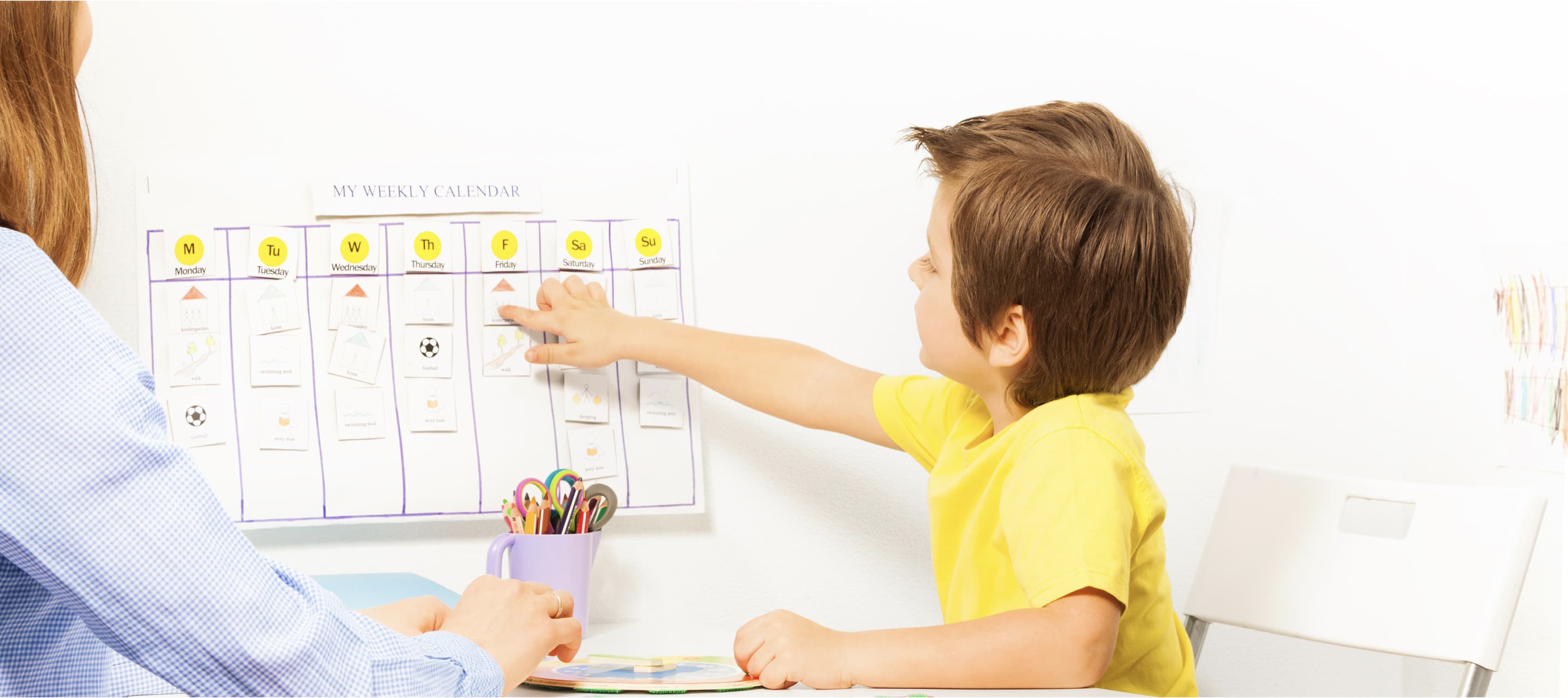ABA visuals are simple yet powerful tools that help children with autism and other developmental needs better understand routines, tasks, and expectations. By turning words into pictures, visuals make learning more concrete, reduce confusion, and support positive behavior. They are also easy to use at home, school, or in therapy, making them an essential tool for promoting independence and confidence.
Understanding the Role of Visual Supports
Sometimes it may be difficult for your child to learn the order of events. This is actually a common problem which ABA visuals can help with. Maladaptive behaviors such as tantrums, aggression, and self-injurious behaviors may occur due to this difficulty with sequential ordering.
Even if you have verbally explained the order of events for the day, it may be difficult for individuals to recall this information readily. This difficulty in the recall is common for many people; independently functioning adults may put alerts in their calendar, alarms, or sticky notes to remember what they need to do or accomplish throughout the day.
These alerts, alarms, or notes are visuals. Visuals are any pictures that can communicate information. Visuals are commonly used throughout daily lives and integrated into many instruction manuals and technological support websites. Pictures of how to build furniture or troubleshooting websites with pictures of solutions are visuals to assist us with the completion of tasks. Many people work well with visuals. If we can see it, we can do it.
Types of ABA Visual Schedules
There are two different kinds of schedules that you can have: an activity schedule or a daily schedule. The activity schedule is a sequence of pictures or words representing each step of an activity. If washing hands or brushing teeth are difficult activities for an individual to complete or remember the sequence of, using an activity schedule for just that one task may be extremely beneficial.
A daily schedule will represent activities that an individual will complete for an entire day. For example, you can have a morning schedule that shows waking up, getting dressed, brushing teeth, and so on.
Both the activity schedule and daily schedule can be combined so that the individual can more successfully manage their day and understand complex tasks while reducing problem behaviors. This may help increase their overall independence. Instead of depending on another person to guide them through the day, they may only need to check their schedule to see what to do next.
These visual schedules can take the form of words or pictures. The estimated time of completion for each task can be included to help them learn to tell time as well. In addition, Velcro patches and checkboxes can be placed next to each task on the visual to keep track of what the individual has already done and what they still need to do. Depending on the individual’s motor function, you can use Velcro patches if it is easier than drawing a checkmark.
Any activity or schedule can be made into a visual and they are easily customizable to every individual’s needs. Visuals can also fade eventually so that an individual can complete activities without them. They can be faded from the more specific tasks to the general tasks. For example, if originally a visual schedule incorporates each step of brushing the teeth, following mastery of teeth brushing, it can eventually be changed to just say “time to brush teeth” on the visual.
Practical Tips for Parents and Educators
Introducing ABA visuals works best when done in manageable steps. Start small, build consistency, and adapt visuals to your child’s needs. Here are a few practical tips:
- Begin simple – Choose one routine, such as getting ready for school, and create a short visual schedule. Once your child understands the system, you can expand it to other daily activities.
- Match visuals to age and ability – For younger children, use real photos or clear images. For older children or teens, icons or written words may be more effective. Keeping visuals age-appropriate makes them engaging and respectful.
- Stay consistent across settings – Use the same style of visuals at home, school, therapy, and in the community. When visual supports are consistent, children are more likely to generalize their skills and use them in social situations.
- Fade gradually – As your child gains confidence, reduce the number of visuals step by step. This promotes independence and prevents over-reliance on the system.
When introduced thoughtfully, visual supports are essential in helping children enhance their ability to manage routines, strengthen communication, and reduce challenging behaviors.
Other Types of Visual Supports in ABA
While daily and activity schedules are common, ABA offers other essential tools that provide structure, guidance, and communication aiding. Some of the most effective include:
- First/Then Boards – These show a simple sequence: first a non-preferred activity, then a preferred one. They are especially useful for transitions and behavior management.
- Choice Boards – A display of pictures or words representing available options. They help children make decisions, support communication aiding, and reduce frustration when words are hard to find.
- Token Boards – A reinforcement system where children earn tokens for positive behavior and trade them for a reward. These are effective for increasing motivation and promoting independence.
- Social Stories – Short, personalized narratives that use words and visuals to explain social situations, daily activities, or expectations. They help build understanding for individuals with autism who may struggle with abstract concepts.

Visual Supports Beyond Therapy
ABA visuals are not only helpful at home or in therapy. They can also be used in the community. Picture cues can make everyday outings less stressful and more successful.
For example, a visual schedule can guide your child through a trip to the grocery store. A first/then board can help during a doctor’s appointment. A choice board can be used at a restaurant so your child can order food without pressure.
Visuals are also useful during playdates and family gatherings. A simple schedule can show when it’s time to play, eat, and clean up. This gives structure in social situations where children may otherwise feel lost. At the park, visuals can outline steps for waiting their turn, climbing the slide, and returning to their caregiver.
When traveling, picture cues are especially powerful. A small visual schedule can prepare a child for airport security, boarding a plane, or even a road trip. Knowing what comes next lowers stress and prevents meltdowns in unfamiliar environments.
These supports help children feel safe and prepared. They also make new places easier to handle. Over time, using visuals in real-world settings builds independence, reduces anxiety, and increases confidence. Parents often notice their child becoming more willing to try new activities when visuals are part of the plan.
Teamwork Between Parents, Teachers, and Therapists
Visual supports work best when everyone uses them in the same way. If parents use one style at home but teachers use a different one at school, children may get confused. Consistency is key.
Caregivers, teachers, and therapists should meet to decide on the same system. This includes the type of visuals, the layout, and the words or symbols used. When children see the same supports across all settings, they are more likely to generalize skills and stay on track.
Working as a team also makes it easier to update visuals as your child grows. Open communication between families and professionals ensures that supports match the child’s current needs. This cooperation helps children move toward independence faster and with fewer setbacks.
Things You Should Know About ABA
Get the must-know facts about Applied Behavior Analysis—all in one guide
Free downloadFrequently Asked Questions About ABA Visuals
1. What age can children start using visuals?
Children can begin using picture cues as early as preschool. Even toddlers can benefit from simple visuals like “eat,” “play,” or “bedtime.”
2. Do visuals replace verbal communication?
No. Visuals are meant to support language, not replace it. They give children an extra tool to understand and express themselves.
3. How do I know when to fade out visuals?
You can start fading when your child shows they can complete the routine with less help. For example, if brushing teeth is mastered, you can reduce step-by-step images to just one card that says “brush teeth.”
4. Are visuals only for children with autism?
No. Visual supports can help many children, including those with ADHD, developmental delays, or speech and language challenges.
5. What if my child resists using visuals?
Start small. Use visuals for one simple routine and pair them with praise or a small reward. Once your child sees success, they may accept them more easily.
6. Do visuals need to be fancy or professional?
Not at all. Simple drawings, printed icons, or even sticky notes can work. The key is clarity and consistency, not design.
7. How do visuals support social skills?
Visuals can model steps in social routines like greeting a friend, taking turns, or asking for help. This makes abstract social rules more concrete and easier to practice.
8. Can visuals be used with siblings or peers?
Yes. In fact, involving siblings or classmates can make visuals more natural. Peers can follow the same schedule, which encourages inclusion and reduces feelings of being “different.”
ABA visuals are extremely beneficial for individuals with difficulties with recall or sequential ordering. It is also minimally intrusive and easily incorporated into every individual’s routine.
If you would like to speak with a specialist about ABA therapy, contact us here. Follow us on Facebook, Instagram, LinkedIn, and Twitter to stay on top of our latest updates.









Leave A Comment